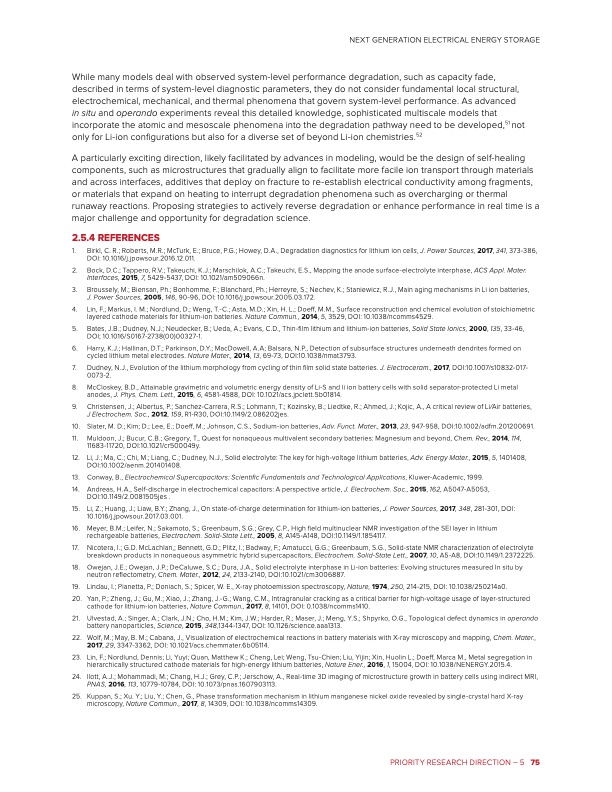
PDF Publication Title:
Text from PDF Page: 081
While many models deal with observed system-level performance degradation, such as capacity fade, described in terms of system-level diagnostic parameters, they do not consider fundamental local structural, electrochemical, mechanical, and thermal phenomena that govern system-level performance. As advanced in situ and operando experiments reveal this detailed knowledge, sophisticated multiscale models that incorporate the atomic and mesoscale phenomena into the degradation pathway need to be developed,51 not only for Li-ion configurations but also for a diverse set of beyond Li-ion chemistries.52 A particularly exciting direction, likely facilitated by advances in modeling, would be the design of self-healing components, such as microstructures that gradually align to facilitate more facile ion transport through materials and across interfaces, additives that deploy on fracture to re-establish electrical conductivity among fragments, or materials that expand on heating to interrupt degradation phenomena such as overcharging or thermal runaway reactions. Proposing strategies to actively reverse degradation or enhance performance in real time is a major challenge and opportunity for degradation science. 2.5.4 REFERENCES 1. Birkl, C. R.; Roberts, M.R.; McTurk, E.; Bruce, P.G.; Howey, D.A., Degradation diagnostics for lithium ion cells, J. Power Sources, 2017, 341, 373-386, DOI: 10.1016/j.jpowsour.2016.12.011. 2. Bock, D.C.; Tappero, R.V.; Takeuchi, K.J.; Marschilok, A.C.; Takeuchi, E.S., Mapping the anode surface-electrolyte interphase, ACS Appl. Mater. Interfaces, 2015, 7, 5429-5437, DOI: 10.1021/am509066n. 3. Broussely, M.; Biensan, Ph.; Bonhomme, F.; Blanchard, Ph.; Herreyre, S.; Nechev, K.; Staniewicz, R.J., Main aging mechanisms in Li ion batteries, J. Power Sources, 2005, 146, 90-96, DOI: 10.1016/j.jpowsour.2005.03.172. 4. Lin, F.; Markus, I. M.; Nordlund, D.; Weng, T.-C.; Asta, M.D.; Xin, H. L.; Doeff, M.M., Surface reconstruction and chemical evolution of stoichiometric layered cathode materials for lithium-ion batteries. Nature Commun., 2014, 5, 3529, DOI: 10.1038/ncomms4529. 5. Bates, J.B.; Dudney, N.J.; Neudecker, B.; Ueda, A.; Evans, C.D., Thin-film lithium and lithium-ion batteries, Solid State Ionics, 2000, 135, 33-46, DOI; 10.1016/S0167-2738(00)00327-1. 6. Harry, K.J.; Hallinan, D.T.; Parkinson, D.Y.; MacDowell, A.A; Balsara, N.P., Detection of subsurface structures underneath dendrites formed on cycled lithium metal electrodes. Nature Mater., 2014, 13, 69-73, DOI:10.1038/nmat3793. 7. Dudney, N.J., Evolution of the lithium morphology from cycling of thin film solid state batteries. J. Electroceram., 2017, DOI:10.1007/s10832-017- 0073-2. 8. McCloskey, B.D., Attainable gravimetric and volumetric energy density of Li-S and li ion battery cells with solid separator-protected Li metal anodes, J. Phys. Chem. Lett., 2015, 6, 4581-4588, DOI: 10.1021/acs.jpclett.5b01814. 9. Christensen, J.; Albertus, P.; Sanchez-Carrera, R.S.; Lohmann, T.; Kozinsky, B.; Liedtke, R.; Ahmed, J.; Kojic, A., A critical review of Li∕Air batteries, J Electrochem. Soc., 2012, 159, R1-R30, DOI:10.1149/2.086202jes. 10. Slater, M. D.; Kim; D.; Lee, E.; Doeff, M.; Johnson, C.S., Sodium-ion batteries, Adv. Funct. Mater., 2013, 23, 947-958, DOI:10.1002/adfm.201200691. 11. Muldoon, J.; Bucur, C.B.; Gregory, T., Quest for nonaqueous multivalent secondary batteries: Magnesium and beyond, Chem. Rev., 2014, 114, 11683-11720, DOI:10.1021/cr500049y. 12. Li, J.; Ma, C.; Chi, M.; Liang, C.; Dudney, N.J., Solid electrolyte: The key for high-voltage lithium batteries, Adv. Energy Mater., 2015, 5, 1401408, DOI:10.1002/aenm.201401408. 13. Conway, B., Electrochemical Supercapacitors: Scientific Fundamentals and Technological Applications, Kluwer-Academic, 1999. 14. Andreas, H.A., Self-discharge in electrochemical capacitors: A perspective article, J. Electrochem. Soc., 2015, 162, A5047-A5053, DOI:10.1149/2.0081505jes . 15. Li, Z.; Huang, J.; Liaw, B.Y.; Zhang, J., On state-of-charge determination for lithium-ion batteries, J. Power Sources, 2017, 348, 281-301, DOI: 10.1016/j.jpowsour.2017.03.001. 16. Meyer, B.M.; Leifer, N.; Sakamoto, S.; Greenbaum, S.G.; Grey, C.P., High field multinuclear NMR investigation of the SEI layer in lithium rechargeable batteries, Electrochem. Solid-State Lett., 2005, 8, A145-A148, DOI:10.1149/1.1854117. 17. Nicotera, I.; G.D. McLachlan,; Bennett, G.D.; Plitz, I.; Badway, F.; Amatucci, G.G.; Greenbaum, S.G., Solid-state NMR characterization of electrolyte breakdown products in nonaqueous asymmetric hybrid supercapacitors, Electrochem. Solid-State Lett., 2007, 10, A5-A8, DOI:10.1149/1.2372225. 18. Owejan, J.E.; Owejan, J.P.; DeCaluwe, S.C.; Dura, J.A., Solid electrolyte interphase in Li-ion batteries: Evolving structures measured In situ by neutron reflectometry, Chem. Mater., 2012, 24, 2133-2140, DOI:10.1021/cm3006887. 19. Lindau, I.; Pianetta, P.; Doniach, S.; Spicer, W. E., X-ray photoemission spectroscopy, Nature, 1974, 250, 214-215, DOI: 10.1038/250214a0. 20. Yan, P.; Zheng, J.; Gu, M.; Xiao, J.; Zhang, J.-G.; Wang, C.M., Intragranular cracking as a critical barrier for high-voltage usage of layer-structured cathode for lithium-ion batteries, Nature Commun., 2017, 8, 14101, DOI: 0.1038/ncomms1410. 21. Ulvestad, A.; Singer, A.; Clark, J.N.; Cho, H.M.; Kim, J.W.; Harder, R.; Maser, J.; Meng, Y.S.; Shpyrko, O.G., Topological defect dynamics in operando battery nanoparticles, Science, 2015, 348,1344-1347, DOI: 10.1126/science.aaa1313. 22. Wolf, M.; May, B. M.; Cabana, J., Visualization of electrochemical reactions in battery materials with X-ray microscopy and mapping, Chem. Mater., 2017, 29, 3347-3362, DOI: 10.1021/acs.chemmater.6b05114. 23. Lin, F.; Nordlund, Dennis; Li, Yuyi; Quan, Matthew K.; Cheng, Lei; Weng, Tsu-Chien; Liu, Yijin; Xin, Huolin L.; Doeff, Marca M., Metal segregation in hierarchically structured cathode materials for high-energy lithium batteries, Nature Ener., 2016, 1, 15004, DOI: 10.1038/NENERGY.2015.4. 24. Ilott, A.J.; Mohammadi, M.; Chang, H.J.; Grey, C.P.; Jerschow, A., Real-time 3D imaging of microstructure growth in battery cells using indirect MRI, PNAS, 2016, 113, 10779-10784, DOI: 10.1073/pnas.1607903113. 25. Kuppan, S.; Xu. Y.; Liu, Y.; Chen, G., Phase transformation mechanism in lithium manganese nickel oxide revealed by single-crystal hard X-ray microscopy, Nature Commun., 2017, 8, 14309, DOI: 10.1038/ncomms14309. NEXT GENERATION ELECTRICAL ENERGY STORAGE PRIORITY RESEARCH DIRECTION – 5 75PDF Image | Next Generation Electrical Energy Storage

PDF Search Title:
Next Generation Electrical Energy StorageOriginal File Name Searched:
BRN-NGEES_rpt-low-res.pdfDIY PDF Search: Google It | Yahoo | Bing
Sulfur Deposition on Carbon Nanofibers using Supercritical CO2 Sulfur Deposition on Carbon Nanofibers using Supercritical CO2. Gamma sulfur also known as mother of pearl sulfur and nacreous sulfur... More Info
CO2 Organic Rankine Cycle Experimenter Platform The supercritical CO2 phase change system is both a heat pump and organic rankine cycle which can be used for those purposes and as a supercritical extractor for advanced subcritical and supercritical extraction technology. Uses include producing nanoparticles, precious metal CO2 extraction, lithium battery recycling, and other applications... More Info
| CONTACT TEL: 608-238-6001 Email: greg@infinityturbine.com | RSS | AMP |